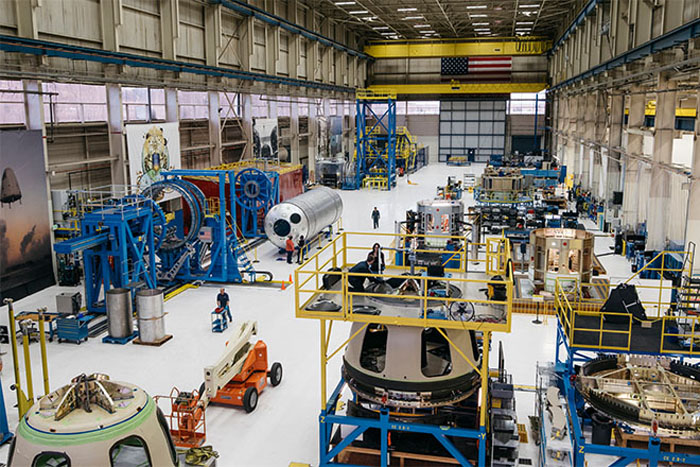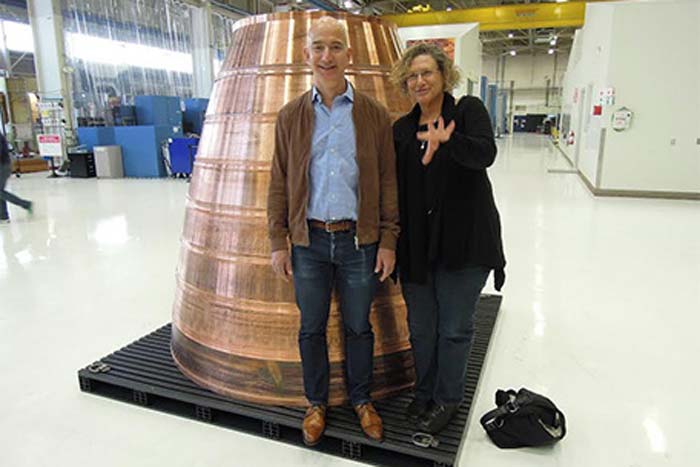Inside Jeff Bezos' Secret Rocket Factory

At the end of the road in an industrial area in the Seattle suburb of Kent looms a half-block of fenced-in hangar-like buildings with no name. This is the headquarters of Blue Origin, the space company owned and bankrolled by Jeff Bezos, the chief executive of Amazon.
With a few notable exceptions, such as launchings and landings of New Shepard, a reusable suborbital spaceship, the company has shielded itself from the public eye. That changed on Tuesday when a group of veteran space reporters spent four hours touring the plant and talking with Bezos and Blue Origin managers.
NEWS: Amazon Founder's Suborbital Spaceship Blasts Off
"It is a change," Bezos told us. "Stuff is finally coming out of this big, long pipeline. It took a long time to get the pipeline filled. And now really exciting, cool stuff that's not just hype is coming out the other end. It's exciting to talk about it and we want the world to know."
"Stuff" is an understatement to describe Blue's products. For starters, there are two more New Shepard capsules coming together on the factory floor. And unlike the New Shepard that is currently being tested, these versions have windows.
The idea is that six people (and no pilots!) will strap themselves into seats and rocket up to 62 miles, or 100 kilometers, above Earth. They won't be flying fast enough to go into orbit, but passengers can experience a few minutes of weightlessness and see the curvature of Earth set against the blackness of space before their ship plunges back into the atmosphere and lands.
PHOTOS: How to Fly Rockets Back to Earth
Get the Space.com Newsletter
Breaking space news, the latest updates on rocket launches, skywatching events and more!
The capsules aren't the only part of the vehicle Bezos wants back. New Shepard's propulsion module, powered by a BE-3 rocket engine Blue designed and built, separates from the passenger ship and lands itself at the launch site, located in Texas. The system is similar to what Elon Musk's SpaceX is working on. Both companies have managed to land rockets intact. In January, Blue Origin also re-launched a flown rocket.
At Blue's factory, technicians are working on two New Shepard propulsion modules, while 3-D printers and other advanced manufacturing machines fashion parts for more. Initially, Blue plans to build six New Shepard vehicles, but is open to boosting production, depending on demand. The company has not yet started selling tickets, nor priced the flights.

Not all six ships will enter commercial service, or even survive testing. One propulsion module has already been destroyed, victim of an April 2015 failed landing attempt. Bezos says a similar fate likely awaits the second propulsion module, which will be used for a high-energy, crew capsule emergency escape test possibly later this year.
NEWS: Dream Chaser Spaceplane to Supply the Space Station
Bezos expects Blue Origin test pilots to begin flying in 2017, and if that goes well, passenger service could start in 2018. But the 52-year-old says he is in no rush.
"I feel very strongly with space (projects) that you can't skip any of the steps," he said.
Most of the tour actually is spent on another Blue project, a rocket engine known as BE-4. Blue began working on it four years ago to power its future orbital rocket. Last year, United Launch Alliance, a partnership of aerospace contractors Lockheed-Martin and Boeing, kicked in what Bezos called a "substantial" but undisclosed sum of money to step up development, with the intention of using BE-4s to replace the Russian engines that power ULA's Atlas 5 rockets. (Congress in 2014 banned Russian engines for use on rockets flying U.S. military satellites as part of trade sanctions following Russia's invasion of Ukraine's Crimea peninsula.)

Bezos doesn't intend to compete against ULA for the military's launch business, but his as-yet-unnamed orbital rockets will be marketed for commercial missions.
It's not that Bezos, already the fifth wealthiest person in the world according to the 2016 Forbes Billionaires list, needs the money. Spaceflight, he says, is a passion, one that has been incubating since he was five.
PHOTOS: Lesson of SpaceX Rocket Landing: Try, Try, Try Again
Ultimately, though, to make his company sustainable, it has to be profitable, even if the payoff is years or decades away.
"I'm perfectly willing to fund this for as long as is necessary," Bezos said, adding that the endeavor already has cost him more than $500 million.
After the tour, Bezos sits down with us and explains the reason why.
"Our vision is millions of people living and working in space," not just for the fun and adventure, but to preserve Earth, he said.
"Energy usage per capita has been growing at a couple of percent a year for a long time … and we really benefit from that," Bezos said.
ANALYSIS: In Space, No One Can Hear You Sneeze
For example, "it's much more energy-efficient to have a baby the old-fashioned way, in your own house, with a neighbor helping, than it is to do it at Swedish Hospital (in Seattle), but your baby's chances of survival at Swedish Hospital are statistically higher," he said.
"We do live, in my view, in a much better world than people lived in 100 years ago and the world they lived in 200 years ago and 300 years ago and a lot of that is tied to our ability to harness energy for ourselves and improve our lives and the lives of our children.
"Even with all the energy-efficiency, our usage continues to grow. If you compound 2 percent for just 200 years, you have to cover the entire Earth's surface with solar cells — high-efficient solar cells. So, in just a few hundred years if we continue to grow our energy usage, we'll be using all of the solar energy that impacts the Earth. That’s an actual limit. You can't argue about it. So you have to ask what do you really want?" Bezos said.
NEWS: Blue Origin Nails Rocket Landing
"We now know for sure that in our solar system, this is the only planet that's really ideal for us … We're not going to find another Earth and we can't cover the whole surface in solar cells. We have only a few hundred years to figure this out," he said
"There are radical solutions, like population control," Bezos said. "I like the idea that we spread out into the solar system and kind of preserve Earth for residential and light-industrial (use), keep this the great planet that it is and move all heavy industry off Earth, where there is, for all practical purposes, limitless energy and limitless resources. I'm talking about over the next few centuries, but that's not a very long period of time."
Besides, he added, venturing into space will be incredibly fun and inspiring. "Who wouldn't want to go do that?"
Originally published on Discovery News.
Join our Space Forums to keep talking space on the latest missions, night sky and more! And if you have a news tip, correction or comment, let us know at: community@space.com.

Irene Klotz is a founding member and long-time contributor to Space.com. She concurrently spent 25 years as a wire service reporter and freelance writer, specializing in space exploration, planetary science, astronomy and the search for life beyond Earth. A graduate of Northwestern University, Irene currently serves as Space Editor for Aviation Week & Space Technology.









